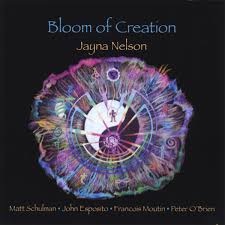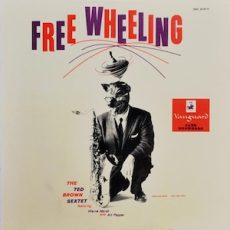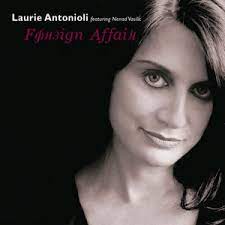
Jazz Poems
JAZZ I’d like to know everything A jazz artist knows, starting with the song “Goodbye Pork Pie Hat.” Like to make some songs myself “Goodbye Rickshaw,” “Goodbye Lemondrop,” “Goodbye Rendezvous.” Or maybe even blues: If you fall in love with me I’ll make you pancakes All morning. If you fall in love with me I’ll make you pancakes all night. If you don’t like pancakes We’ll go to the creperie. If you don’t like pancakes We’ll go to the creperie. If you don’t like to eat, handsome boy, Don’t you hang around with me. On second thought, i’d rather find The fanciest music I can, and hear all of it. I’d rather love somebody And say his name to myself every day Until I fall apart. ANGELA BALLfrom Jazz Poems ~ Selected and Edited by Kevin Young
More Posts: book,classic,collectible,history,jazz,library,poet

Daily Dose Of Jazz…
Maria Viana was born on March 17, 1958, Lisbon, Portugal and was the daughter of famous actor and painter, José Viana; and Brazilian singer and actress Jujú Baptista. A meeting with jazz critic and missionary José Carlos Monteiro Costa introduced her Ella Fitzgerald, Billie Holiday, Sarah Vaughan and Anita O’Day. He also introduced her to the producers of Cascais Jazz Festival, Luis Villas-Boas and Duarte Mendonça who took an immediate interest in her, arranging for rehearsals and jam sessions.
It was not until 1983 that she vigorsly pursued her professional ambitions in Jazz, because previously she had been an actress and a famous popsinger. She became the host-singer at the jazz bar, Drogaria Ideal, where dozens of soloists, amateurs and professionals performed. Within months Maria’s career progressed and revealed unquestionable talent and abilities.
She would go on to do television, festivals, record, and work with Al Grey, Bernardo Sasseti, and David Gausden. She created the Maria Viana Quintet, and toured the country for the National Secretary of Culture. 1995 Produces / features in concert, Around the World, Around the Forties, for the celebration of fifty years since the Second World War ending; an initiative of C.M. de Cascais. Tours Portugal with her quintet, and tours with Bill Goodwin quintet.
Maria’s work is rewarded with a Declaration of Manifest Cultural Value, has guested on several recordings and concerts, and became the Artistic Director for Hotels with Jazz. She produced Jazz na Casa da Guia, and Blues for Cascais, benefiting an ecological organization in Cascais.
Through the years vocalist Maria Viana has been featured on over sixty national television shows and concerts and continues to perform and tour.
More Posts: bandleader,history,instrumental,jazz,music,vocal

Daily Dose Of Jazz…
Jayna Nelson was born in Lincoln, Nebraska on March 16, 1958. She began to study piano as soon as she could reach the keyboard. At age 9 she began to study the flute as well and by age 17 had won both the Baldwin Junior Keyboard award and the l Music Teachers’ National Association Competition.
Graduated from the University of Toronto in Flute Performance, for the next two years, she served on the faculty at University of Toronto teaching chamber music. There she also premiered a work by Mario Davidovsky, and was principal flutist with the Union College Orchestra, the Wesleyan College Orchestra, Opera Omaha Orchestra and Symphony Canada. In 1983 she attended the Banff Centre Jazz program headed by Dave Holland and studied and performed with Anthony Braxton, Don Thompson, Dave Liebman and John Abercrombie.
A move to New York City in 1989 saw her continuing to work in the classical and jazz genres as a performer, producer, composer, arranger and educator. She designed and implemented integrated arts curriculum for New York area schools and summer camps. She has lectured and given seminars, maintained a private teaching studio for over 20 years and has been a flute technician and consultant for Anthony Braxton, Dave Liebman, Joe Giardullo, Jeanne Baxtresser, Joannie Maddon, Carlos Malta, Hermeto Pascoal, and James Moody.
Nelson has recorded and performed with a host of musicians including Karl Berger, Hilliard Green, Howard Johnson, Silvana Malta, Francois Moutin, Hermeto Pascoal, Sirius String Quartet, Petula Clark, Ingrid Jensen, Marty Morrell, Dave Valentine, and numerous others.
Flutist Jayna Nelson continues to perform, tour, compose, record and educate.
More Posts: arranger,bandleader,composer,educator,flute,history,instrumental,jazz,music,producer

Requisites
Free Wheeling ~ The Ted Brown Sextet Featuring Warne Marsh and Art Pepper | By Eddie Carter
I first heard a track from Free Wheeling (Vanguard VRS-8515) by The Ted Brown Sextet a few years ago on Sirius XM’s Real Jazz. I’ve loved the tenor sax since I was a child, so I was ecstatic to discover a new musician and finally get a copy. It was Ted’s first release as a leader, and the music within it is an excellent representation of West Coast jazz. During his career, he recorded with Lee Konitz, Hod O’ Brien, and Lennie Tristano, and on this date, he’s joined by Art Pepper on alto sax, Warne Marsh on tenor sax, Ronnie Ball on piano, Ben Tucker on bass, and Jeff Morton on drums. My copy is the 1975 King Record Company Japanese Mono reissue (Vanguard GXC 3121M).
Side one starts with the front line’s brisk introduction to Aretha by Ronnie Ball. Ronnie infuses the first solo with energy and agility. Art and Warne follow in successive order, hitting an ideal groove. Jeff is up next with a brief but lively finale ahead of the sextet’s theme’s restatement and climax. The ensemble moves the needle upward for Long Gone by Warne Marsh. The front line sets the mood in the opening chorus; then, Ted makes his entrance first for an exciting solo. Warne steps up next and takes the reins. Ronnie follows with a swift reading; then Art gets right to work and cooks. Jeff signals the end with a brief comment into the closing chorus and ending.
Once We Were Young by Walter Gross is a lovely song that Ted begins with a dreamy melody that Warne picks up in the background. Ronnie comes in for a short, sensitive interlude until both horns return for a beautiful theme restatement and tender climax. Foolin’ Myself is the creation of Andy Razaf and Thomas “Fats” Waller. The rhythm section starts with a mid-tempo introduction, segueing into the catchy melody. Ronnie takes the lead and gives an enchanting interpretation. Ted begins the second statement, then is joined by Art and Warne in succession for a hauntingly sincere reading that concludes softly.
The sextet takes us to Avalon by Al Jolson, Buddy DeSylva and Vincent Rose. The song’s title comes from a California city, and the front line kicks off the lively melody together. Ted goes first and makes a vigorous opening statement. Jeff succeeds him and delivers the goods in a spirited conversation with the leader before the group reconvenes to take the song out. On a Slow Boat To China by Frank Loesser starts Side Two with the sextet slowing the beat slightly for the opening chorus. Ted is thoroughly at ease in the first interpretation, and then Ronnie takes a few lovely choruses. Ted and Ronnie have a short exchange preceding the song’s conclusion.
Crazy She Calls Me by Carl Sigman and Bob Russell begins with the ensemble’s moving, deeply satisfying theme. Warne is the first soloist, and from his horn, notes of velvety softness flow. Ronnie expresses the song’s sentimentality next. Ted handles the following reading with a good deal of warmth, and then Warne returns to help bring the song to a gorgeous climax. Broadway by Wilbur H. Bird, Teddy McRae and Henri Woode opens with the front line’s collective melody. Warne, Art, and Ted are the first three in the solo spotlight, followed by an ensemble chorus together. Ronnie takes a splendid reading next, then Ben has a short summation as Jeff keeps perfect time toward the finale.
Arrival by Ronnie Ball is our final stop in this cool jazz session, and it’s off to the races from the start of the melody. Art leads the way with a swift opening statement. Warne delivers the second solo fleetingly; then, both horns make quick work of the finale in an exchange with Jeff before taking the song out. Alfred Marx supervised the original session, and the Vanguard Recording Society, Inc. recorded it. The sound quality of this reissue is exceptionally good and for a vintage fifties recording, exceeded my expectations. The music is also excellent, as is the pressing, and the vinyl is noticeably quiet.
There is one error on my copy, which doesn’t appear on the original album. The composers for Crazy She Calls Me are incorrectly listed on the Side Two label as the team of Cahn and Mayer but actually are Carl Sigman and Bob Russell. The album cover is also one of the strangest I’ve ever seen, but don’t let that dissuade you from checking out Free Wheeling by The Ted Brown Sextet on your next record hunt. If you’re a fan of cool jazz or West Coast Jazz, it’s a great-blowing session with Warne Marsh and Art Pepper and a wonderful introduction to a musician deserving of wider recognition. To borrow a quote from the great Vin Scully in game one of the 1988 World Series, “Not a bad opening act!”
~ Avalon – Source: JazzStandards.com ~ Broadway, Crazy She Calls Me, On a Slow Boat To China – Source: Wikipedia.org © 2024 by Edward Thomas Carter
More Posts: choice,classic,collectible,collector,history,instrumental,jazz,music,saxophone

Daily Dose Of Jazz…
Laurie Antonioli was born on March 9, 1958 in Marin County. California. At the age of sixteen she began playing guitar and performing primarily her own original music as well as that of the singer-songwriters of the era. In 1975 she won the American Songwriters Contest for high school students, studied jazz at Mt. Hood Community College in Gresham, Oregon and Cal State Long Beach. She took private lessons from Mark Murphy and Joe Henderson.
After graduation, Laurie continued composing and performing. In 1980 she toured Europe for eight months with New Orleans saxophonist Pony Poindexter. When he suffered a stroke, a record date in Paris with pianist Kenny Drew was canceled and they were unable to finish out their tour. Laurie brought Pony back to California where she lived and led her own bands based out of San Francisco.
1985 saw Antonioli signing with Catero Records and her first album was the live two-track Soul Eyes, with the title song given to her by composer Mal Waldron. She was accompanied by pianist George Cables. After a hiatus from music, she settled in Vienna, Austria from 2002 to 2006 and began recording again.
Her Nabel Records album Foreign Affair was a Balkan jazz hybrid recorded in Slovenia with musicians from Serbia, Albania, Germany, and the U.S. It was well received in Europe. Her next album The Duo Session enlisted Richie Beirach where she wrote lyrics to his compositions. Laurie also wrote lyrics to some Miles Davis tunes and free improvisation pieces. This recording was also well-received but like Foreign Affair was known primarily to European audiences.
As an educator she held the position of Professor of the Vocal Department at KUG University’s Jazz Institute in Graz, Austria from 2002 to 2006 while living and performing in Europe. Antonioli was offered a position at the California Jazz Conservatory in Berkeley, California as the school’s vocal program director and created an eight-semester vocal performance curriculum. Singer and record producer Laurie Antonioli, who between 1985 and 2018 she has recorded seven albums, continues to perform and record.
More Posts: educator,history,instrumental,jazz,lyricist,music,vocal




